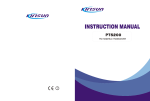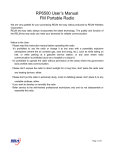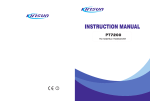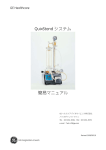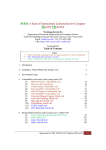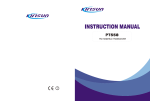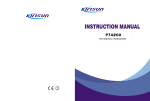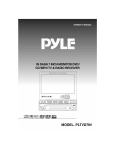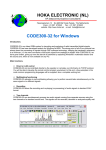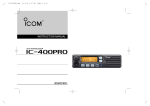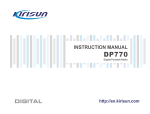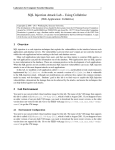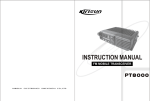Download PT6500 User Manual
Transcript
INSTRUCTION MANUAL PT6500 FM HANDHELD TRANSCEIVER NOTE INSTRUCTION MANUAL PT6500 FM HANDHELD TRANSCEIVER We are very grateful for your purchasing brand twoway radios produced by Kirisun Electronics (Shenzhen) Co., Ltd. We believe two-way radio, which always incorporates the latest technology, can bring great convenience to your life and work; We also believe that the quality and function of twoway radio can meet your demands for reliable communication. PRECAUTIONS Please observe the following precautions to prevent fire, personal injury, and radio damage. Do not operate your radio while taking on fuel, or being charged. Do not expose the radio for a long period to direct sunlight, nor place the radio close to heating appliances. Do not place the radio in excessively dusty areas, humid 29 areas or on unstable surfaces. Do not modify this radio for any reason. Refer service to qualified licensed or certificated technicians only. Notice to the User: Government laws prohibit radio communication without permission in government districts. Illegal operation is subject to punishment by fine and/or imprisonment. Refer service to the well-trained professional technicians only. Safety It is important that the user is aware of and understands hazards common to the operation of any radios. Warning! Turn off your radio before entering any area with a potentially explosive atmosphere (where the air contains gas, dust and smog, etc.), such as while taking on fuel, or while parking at a gasoline service station. Precautions in Use Please comply with the following attentions to avoid fire, bodily injury and damage to the radio. The radio is recommended to transmit for 1 minute and receive for 4 minutes. Long time transmitting or continuous working in high power mode will make the rear side of the radio generate heat. Please don't disassemble or assemble the radio under any circumstances. Please don't expose the radio to direct sunlight for a long time; don't place the radio near any heating devices, either. Please don't put the radio in extremely dusty, moist or dabbling places; don't place it on any unstable surfaces, either. If the radio emits smoke or strange odors, turn it off and remove the battery from the radio and promptly contact your local authorized Kirisun dealer. V071123 CONTENTS Unpacking and checking..............................................................1 Supplied accessories ..................................................................1 Preparation...................................................................................2 Charging the battery..................................................................2 Installing/Removing the battery pack.........................................3 Installing the antenna.................................................................4 Installing the optional speaker/microphone...............................4 Installing the belt clip.................................................................4 Radio Overview............................................................................5 Basic Operation............................................................................7 Programmable Button functions.................................................14 VOX............................................................................................22 Whole setting..............................................................................22 Time-out Timer TOT ...........................................................22 Battery Saving..........................................................................23 Low Power Warning.................................................................23 Channel Annunciation..............................................................24 CTCSS/ DCS User's resolution................................................24 Busy Channel Lockout BCL ................................................24 Receiving Squelch Mode.........................................................24 DTMF signaling .......................................................................25 2TONE signaling .....................................................................25 5TONE signaling .....................................................................26 Transmit beginning/ending signaling (PTT ID) ........................26 Problems and troubleshooting .................................................27 Major Specifications...................................................................28 Status setting..............................................................................29 UNPACKING AND CHECKING EQUIPMENT Carefully unpack the radio. We recommend that you identify the items listed in the following table before discarding the packing material. If any damage has occurred during shipment, please contact the dealer immediately . PREPARATION CHARGING THE BATTERY PACK Plug the power adapter into the proper AC wall outlet; and insert the cable of the power adapter into the adapter socket on the charger; then the charger indicator lights green. SUPPLIED ACCESSORIES ITEM QUANTITY Antenna Power adapter 1 Belt clip 1 1 Charger 1 Hand strap Li-Polymer battery 1 1 Instruction manual 1 Insert the battery or the radio to be charged into the charger slot. Make sure the battery is in good contact with the charger terminals. When the red indicator lights, the charger begins to charge the battery. After charging for about 5 hours, the red indicator turns dim and the green indicator lights indicating the battery has been fully charged. Leave the battery in that sate of green indicator for 1~2 hours before you remove it from the charger to achieve the best performance of the battery. Then you can disconnect the power adapter from the AC outlet. Antenna Charger 1 Power adapter Belt clip Battery Hand strap Notes: * The battery is not fully charged in the factory. Before the initial use, please charge the new battery. * The KB-36A Ni-MH battery/KB-36C Li-Ploy battery of Kirisun is adaptable with this radio. * When you charge the battery the first time or after long time storage 2 (2 months), several times of charging is needed. Make sure the battery is charged at least once every three months. * Do not charge the battery again if it is charged fully or not in the lowpressure warning mode, otherwise, it will have bad effects on its life and performance. Remove the battery from the charger after charging. * When you use the KB-36A battery, and the transceiver is in the lowpower warning mode, recharge the battery before use. Do not start up by force; otherwise, it will have bad effects on its life and performance. * There is a protection circuit in KB-36C battery, so the power will be cut off at too low power. INSTALLING /REMOVING THE BATTERY PACK Installing the Battery Pack Match the 3 bulges of the battery pack with the corresponding slots at the rear bottom of the radio. INSTALLING THE ANTENNA Screw the antenna into the connector at the top of the transceiver by holding the Button of the antenna and turn it clockwise until secure. INSTALLING THE OPTIONAL SPEAKER/ MICROPHONE Insert the speaker/microphone plug into the jacks of the versatile connector. Installing the Battery Pack Then firmly press the battery pack downwards to lock it in place until a click is heard. Removing the Battery Pack To remove the battery pack, use your thumb to press the belt clip, one side of your index finger to press the release button and then pull the battery away from the radio. Notes: INSTALLING THE BELT CLIP Match the grooves of the belt clip with those on the rear of the battery. Then press belt clip downwards to lock it in place. Push the card by inserting your nail or tool into the groove at the upper part of the clip to remove the belt clip. not cause short-circuit or throw the battery to the fire. * Do * Do not disassemble the battery by yourself. 3 4 RADIO OVERVIEW P1 P3 P2 P4 1 2 3 4 5 6 7 8 9 * 0 # The functions of the components are as follows: A. LED Indicator Lights red while transmitting; Lights green while receiving. B. Power/Volume Switch Knob Turn clockwise till a click is heard to switch on the radio. Turn counterclockwise till a click is heard to switch off the radio. Rotate to adjust the volume after turning on the radio. C. Channel Selector Rotate to select the channel 1-128. D. Antenna E. Top Button (programmable button) It is recommended to be set as the emergency warning Button. F. Side button 1 (programmable button) G. PTT PUSH-TO-TALK : To make a call, press and hold the PTT button, then speak into the microphone with normal voice. Release the PTT button to receive signals. H. Side button 2 (programmable button) 5 I. Button P1 Return and delete button in the menu. J. Button P2 Select Button. K. Button P 3 Select Button. L. Button P4 Enter and Confirm Button. M. Numeric keypad N. Microphone/speaker jacks For connecting microphone/speaker. Explanation for the screen P Icon Description Signal intensity SVC P SVC Compandor Disturbance Frequency Busy channel lockout Scanning Key lockout Signal reminder is programmed Battery capacity, flashes when the battery power goes too low 6 BASIC OPERATION 1.Switch On Switch on the radio by turning the Power/Volume switch clockwise till a click is heard, then the radio will be in the state of stand by and you will hear a beep if the dealer has set it. 2.Adjust Capacity Press the button preset as canceling squelch to listen to the background noise and rotate the Power/Volume switch to adjust capacity. 3.Select Channels Rotate the channel selector to select channels. You will hear voice from the speaker while receiving proper signals. P 7 As shown in the above right figure: Zone 1 is the zone of current channel (8 zones from 0 to 7). H is the transmit power of the channel, H stands for high power, M for middle power while L for low power. CHANNEL 1 is the current channel (128 zones from 1 to 128). 4. Make a Call To make a call, press PTT, and speak in normal voice. Please keep your mouth 3~4 cm away from the microphone. 5. Receive a Call Release the PTT button to receive a call. Your dealer can set CTCSS, DCS, 2 Tone signaling on your radio channels by PC software. If you select a channel that has been preset with the tone signaling, you will not hear any other calls except those from your own system. 6. Operation on menu: P4 press button to enter the menu or confirm any contents; P press button to return to the previous menu or cancel the set. When entered the menu, select the sub-menu with the P3 channel selector , or . P2 The menu is as follows: 1 8 Utilities Scan ON/OFF Key tone ON/OFF Back Light Squelch Level ON/OFF Level: 0~9 Scrambler Save ON/OFF Power Level H M L Companding ON/OFF Phone Menu Rptr/Talkamd P2 / P3 , then press to P4 If can not enter that way, you have to set in PC communications; Set back light: 1. As shown: in CH 1 , press P4 , Utilities is shown. P4 2. Press to enter select mode, 3. Press P2 / P 3 , and Back Light is shown, 4. Press P4 to select On or OFF , 5. Select On or OFF with P2 / P 3 , press P4 to confirm. Set the squelch level: 1. As shown: in CH 1 , press P4 , Utilities is shown. P4 2. Press to enter select mode, 3. Press P2 / P 3 , then Squelch Level is shown, 4. Press P4 to select squelch level, e.g., Level 0 5. Change the squelch level with P2 / P 3 , then press P4 to confirm. Speak mode Zone Edit Call Ch Edit Rx FRQ Tx FRQ Rx CTCSS Tx CTCSS The operations are as follows: Set scanning: 1. As shown: in CH 1 , press P4 , then Utilities is shown; 2. Press P4 , then Scan is shown; 3. Press P4 , then enter selecting Scan ; 9 4. Select Scan On or Scan OFF with confirm it. Set power level (high/middle/low): 1. As shown: in CH 1 , press P4 , utilities is shown. P4 to enter select mode, 2. Press 3. Press P2 / P 3 , then Power Level is shown, 4. Press P4 to select, e.g., Power Low , P4 to confirm. 5. Change the power level with P2 / P 3 , then press Set Companding P4 , 1 As shown: in CH 1 , press 2. Press P4 to enter select mode, 3. Press P2 / P 3 , and Companding 4. Press P4 to select Companding , 5. Select On or OFF by P2 / P 3 , press Utilities is shown. is shown, P4 to confirm. 10 Set saving 1 As shown: in CH 1 , press P4 , Utilities P4 to enter select mode, 2. Press 3. Press P2 / P 3 , and Save is shown, P4 4. Press to select Save 1 4 , 5. Chang the save percentage with P2 / P 3 , press 3. Press P4 to select the speak on mode, 4. Select with P2 / P 3 , press P4 to confirm. is shown. P4 to confirm. Set scrambler 1 As shown: in CH 1 , press P4 , Utilities is shown. 2. Press P4 to enter select mode, 3. Press P2 / P 3 , and Scrambler is shown, P4 to select, e.g., 4. Press Scrambler OFF , 5. Select On or OFF by P2 / P 3 , press P4 to confirm. Set key tone P4 , 1 As shown: in CH 1 , press Utilities is shown. 2. Press P4 to enter select mode, 3. Press P2 / P 3 , and Key Tone is shown, P4 4. Press to select OFF or On , 5. Select On or OFF with P2 / P 3 , press P4 to confirm. Set Rptr/Talkarnd P4 to enter select mode, 1 As shown: in CH 1 , press 2. Press P2 / P 3 , and Rptr/Talkarnd is shown, P4 to select the mode, 3. Press 4. Select Repeater Mode or Talkarnd mode with P2 / P 3 ,press to confirm. Set speak On mode P4 to enter select mode, 1 As shown: in CH 1 , press 2. Press P2 / P 3 , and Speak Mode is shown, 11 Set zone mode 1 As shown: in CH 1 , press P4 to enter select mode, 2. Press P2 / P 3 , and Zone Edit is shown, 3. Press P4 to select the zone mode, 4. Select Zone No with P2 / P 3 , press P4 to confirm. Set call list 1 As shown: in CH 1 , press P4 to enter select mode, P3 P2 / 2. Press , and Call is shown, P4 to select the call list, 3. Press 4. Select with P2 / P 3 , press PTT to transmit. Set Rx FRQ 1 As shown: in CH 1 , press 2. Press P2 / P 3 , and Ch Edit P4 3. Press to select Ch alias P4 to enter select mode, is shown, CHANNEL 1 4. Press P3 , Rx FRQ 401.660000 is shown, enter the set of Rx FRQ, 5 Set the Rx FRQ value with the keypad, 6. Press P to delete, and press P4 to confirm. 1 P4 Set Tx FRQ 1 As shown: in 2. Press P2 / P 3 3. Press to select CH 1 , and , press Ch Edit P4 to enter select mode, is shown, Ch alias CHANNEL 1 12 4. Press P3 , Tx FRQ 401.660000 is shown, enter the set of Tx FRQ, 5 Set the Tx FRQ value with the keypad, P4 6. Press P to delete, and press to confirm. 1 Set Rx CTCSS/DCS 1 As shown: in CH 1 , press P4 to enter select mode, 2. Press P2 / P 3 , and Ch Edit is shown, 3. Press P4 to select Ch alias CHANNEL 1 4. Press P3 , Rx CTCSS is shown, enter the set of Rx 401.660000 CTCSS/DCS FRQ 5 Set the Rx FRQ value with the keypad, 6. Press P to delete, and press P4 to confirm. 7. to convert among * Stands for the radix point, press CTCSS DCS and reverse DCS. 1 Set Tx CTCSS/DCS 1 As shown: in CH 1 , press 2. Press P2 / P 3 , and Ch Edit Ch alias 3. Press P4 to select P4 to enter select mode, is shown, CHANNEL 1 4. Press P3 , Tx CTCSS XXXX is shown, enter the set of Tx CTCSS/DCS FRQ, 5. Set the Tx FRQ value with the keypad, 6. Press P to delete, and press P4 to confirm. 7. to convert among * Stands for the radix point, press CTCSS DCS and reverse DCS. 1 13 Set contact list 1 As shown: in CH 1 , press P4 to enter select mode, 2. Press P2 / P 3 , and Contact List is shown, 3. Press P4 to select, 4. Select the address cable of the call to be made with P2 / P 3 , 5 Check the alias or address code by turning the knob, 6. Key in the address code of the person you are calling, 7. Press P4 to transmit the current contact list. Set status: 1 As shown: in CH 1 , press P4 to enter select mode, 2. Press P2 / P 3 , and Status is shown, 3. Press P4 to select, 4.Select the needed status with P2 / P 3 , 5. Check the alias or address code of the status by turning the knob, 6. Press P4 to select the current status. PROGRAMMABLE BUTTON FUNCTIONS The dealer can program the 2 Side Buttons and 1 top Button with one of the following auxiliary functions. None OFF ( do not set the functions ) Scan lone working Contact list Power selector Show or hide the channel alias Busy Channel Lockout (BCL) 14 Key lock Squelch level selector Companding Scrambler Battery power Zone Monitoring Cancel Squelch Emergency Alert Back light Rptr/Talkarnd Express select channel 1 Express select channel 2 Call 1, 2, 3 or 4 Channel lock Adjust display contrast Notes: programmable key can be set as short press or long press. The following functions can be programmed by the dealer: None Set of None Scan Press the button set as Scan to start scanning. When carrier wave scan is enabled. While in scanning, the radio checks every channel (any channel in any zone) and stops on the channel on which a signal is detected until that signal disappears. If interval between signal disappearing and continuing scanning has been preset, the radio will remain on that channel. Only when there are two channels added in the scan list and the scan function has been activated, the radio can 15 start scanning. It can be set as: short press: scan, long press OFF. 1. Press the programmable key once to start scanning (it should be effective in the channel scan list). 2. Press once to quit. Notes: there are 8 zones from 0 (default zone) to 7; and there can be as many as 128 channels in each zone. There are totally 16 scan lists; you can select any scan list. Every scan list can scan any channels in different zones (16 channels to the most). Lone working Press the button set as lone working to start lone working. This mode is to ensure the safety of the user while using the transceiver separately. It can be set as: short press : personal working, long press OFF. 1. Press the programmable key once to start personal working; 2. Press once again to quit. Notes: The lone working is connected with the automotive checking in the programming software, and will be effective when both are set. Contact list Enter the Contact list quickly: It can be set as: short press: contact list, long press OFF. 1. Press the programmable key once to enter the contact list Call 2. Press again to enter the content interface of the contact list, 3. Select the options in the contact list with P2 / P 3 4. Press PTT to transmit 5. Press P to quit. 1 16 Power select Rotate the channel selector to enter the quickly. There are high, middle and low levels. power level menu It can be set as: short press: power select, long press OFF. 1. Press the programmable key once, Zone 0 L will be shown, CHANNEL 1 2. Press it again, Zone 0 M will be shown, CHANNEL 1 3. Press it a third time Zone 0 H will be shown. CHANNEL 1 Busy Channel Lockout (BCL) Busy Channel Lockout can prevent you from interfering other radios that using the same channel. Press the PTT button, if the channel is busy, the radio with BCL function active will make warning sound and prohibit transmitting. To stop the warning sound, please release the PTT button and the radio returns to receiving mode. It can be set as: short press : Busy Channel Lockout, long press OFF. 1. Press the programmable key once, BCL none will be shown, 2. Select the character you need with P2 / P 3 , e.g.: BCL none BCL carry BCL carryPL 3 17 Press P4 to confirm. Key lock Press the key programmed as key lock for one second to lock/unlock the keys for the transceiver. It can be set as: short press: key lock, long press OFF. 1. Press the programmable key once, CHANNEL will be shown, 2. Press it again, CHANNEL will be shown. Squelch level Selector Enter the Select squelch level rapidly, 0~9 levels are available with the channel selector. It can be set as: short press: Select squelch level, long press OFF. 1. Press the programmable key once, Level 2 will be shown, 2. Select squelch level with 3. Press P4 P2 / P3 , e.g.: Level 3 Level 4 Level 5 to confirm. Companding Enter the Companding mode when press the key programmed as Companding , It can be set as: short press: Companding, long press OFF. 1. Press the programmable key once to open the Companding mode, Zone P will be shown, CHANNEL 1 2. Cancel the mode by pressing it again, Zone will be shown. CHANNEL 1 18 Scrambler Press the key programmed as scrambler to prevent any third party to hear you talking on the phone. It can be set as: short press: scrambler, long press OFF. 1. Press the programmable key once to open the scrambler mode, CHANNEL 1 will be shown, 2. Cancel the mode by pressing it again, CHANNEL 1 will be shown. Battery volume checking Display the battery power. It can be set as: short press: battery power checking, long press OFF. 1. Press the programmable key once: the battery power will be shown, 2. Press again: close the display. Monitoring Press the programmed as monitor trigger to hold out CTCSS DCS 2Tone and DTMF signal, and you can hear the signals can not be heard in normal operation, press the key again to return to normal operation. It can be set as: short press: monitor, long press OFF. 1. Press the programmable key once to start monitoring, Moni Moment ON will be shown, 2. Press again: stop monitoring, Moni Moment OFF will be shown. Cancel squelch Press the key, no matter what the signal or carrier wave is (including 19 optional signal), squelch will be cancelled. It can be set as: short press: cancel squelch, long press OFF. 1. Press the programmable key once to start squelch constantly, 2. If you do not press it, the squelch will still work. Emergency Alert If press the top key programmed as Emergency Alert , you can give the warning ring according to the programming software, or send your identity or background music to your companion or the system. ?It can be set as: short press: emergency alert, long press OFF. 1. Press the programmable key once to start alert, 2. Press it again to stop the alert. Back light Turn on/OFF the back light. It can be set as: short press: back light, long press OFF. 1. Press and hold on this key, the back light is on, 2. Release it to recover the normal mode. Rptr/Talkarnd When press the key programmed as Rptr/Talkarnd , the next transmission will be at the same frequency as at which it is received. It can be set as: short press: Rptr/Talkarnd, long press OFF. 1. Press the key once, Rptr/Talkarnd will be shown, 2. Press P4 to enter, 3. Press P / P 3 to select the character you need: e.g.: Repeater Mode or Talkarnd Mode , P4 4. Press to confirm. 2 Instantly select the channel Shift to the channel you selected instantly, so that you can communicate at the channel you are used to. 20 It can be set as: short press: instantly select channel 1, long press OFF. 1. Press the key once to instantaneously select the channel, e.g. CHANNEL 15 2. Press again to return. 1. Press the key once, display the channel alias, e.g.: CHANNEL 1 , 2. Press it again, the channel frequency will be shown, e.g.: 401.66500 Call 1, 2, 3, or 4 Press the side button programmed as Call 1, 2, 3, or 4 to transmit the specified code stored in the contact list. Release Call button, and speak to the microphone to call with the PTT button still pressed. It can be set as: short press: Call 1, long press OFF. 1. Press the key once to make a call (within the current channel), and will quit automatically after the call. It can be set as: short press: Zone, long press OFF. 1. Press the key once, Zone No will be shown, 2. Select zone No. with P / P 3 , 3. Press P4 to confirm. 3. Press it a third time the channel alias will be shown, e.g.: CH 1 2 It can be set as: short press: channel lock, long press OFF. 1. Press the key once to perform channel lock, then you can not choose the channel, Channel Annunciation Select or delete the voice annunciation function. CHANNEL 1 will be shown. 2. Press it again to cancel channel lock, CHANNEL 1 will be shown. Adjust display contrast You can adjust the display contrast as per your need. It can be set as: short press: display contrast, long press 1. Press the key once, Contrast will be shown, 2. Press P / P 3 to select the character you need, 3. Press P4 to confirm. OFF. 2 Manual programming The dealer can open the manual programming rights of channel frequency set, CTCSS DCS. Basic operations of programmable keys: You can set the programmable keys with the key set in PC software, as follows: It can be set as: short press: display channel frequency, channel alias and channel No., long press OFF. 21 VOX VOX function enables you to use the radio without manual operations. This function can only be set by the dealer, and you have to be equipped with the specified earphones. Before using VOX, you must set VOX gain level. Such setting enables the radio to identify the voice volume. If the microphone is too sensitive, the background noise will trigger the radio to transmit. If the microphone is not sensitive enough, it cannot receive your voice when you speak. Make sure to adjust VOX gain level to proper sensitivity. Programmable Functions (programmed with PC) Time-out Timer (TOT) 22 TOT timer: Time-out timer can prevent any caller from occupying one certain channel for an extended period of the time. The radio is set with a continuously transmitting limit. If the radio is continuously transmitting longer than the time preset by the dealer, the radio will stop transmitting and warning TOT forbidden period: A period in which the radio is forbidden to transmit after its overtime activity. During the period, if the PTT key is pressed, there will be a warning tone, and transmitting is forbidden. TOT pre-warning: The pre-warning will sound before the TOT action. After the sound of the warning, the timer will take action when the transmitting time has gone beyond the limit. TOT reset: The time delay from releasing the PTT key to the resetting of the timer is limited. The countdown will go on if the time after releasing the PTT key is shorter than the reset time. Battery Saving The dealer can set the type of this function by programming. If the battery saving function is on, 10 seconds after the radio hasn't receive any signals or no operation is being acted, the radio enters battery saving mode. When a signal is received or any operation occurs, it exits battery saving mode automatically. The types include: 1 1, 1 2, 1 4 and OFF. The automatic battery saving function decreases the power consumption. Channel Annunciation 23 The dealer can turn on or turn off this function by programming. While switching to another channel, you can hear the voice annunciation of the current channel number. CTCSS/ DCS The dealer can set CTCSS/DCS tones on radio channels, which enable you to ignore (not hear) calls from other irrelevant parties who are using the same channel. When you receive a signal that has a tone different from the one set on your radio, you will not hear the signal. Likewise, signals that you transmit will only be received by parties whose CTCSS/DCS tones are the same as yours. Note: Using a CTCSS/DCS channel doesn't mean your calls are private. If other parties' CTCSS/DCS tones are identical with yours, they can hear your calls. USER RESOLUTION Busy Channel Lockout (BCL) Busy Channel Lockout can prevent you from interfering other radios that using the same channel. Press the PTT button when the channel is busy, the radio with BCL function active will make warning sound and prohibit transmitting. To stop the warning sound, please release the PTT button and the radio returns to receiving mode. The dealer may provide the following two lock mode: Carrier wave: it will be locked if there is any Carrier wave; Carrier wave+ CTCSS/DCS transmitting is permitted if there are matched CTCSS/DCS in the channel. Receiving Squelch Mode The dealer may set the condition under which to turn on the speakers: 24 1. CTCSS/DCS and audio squelch: only when the CTCSS/DCS and optional signaling are patchable. 2. Audio squelch: once the optional signaling is matchable. 3. CTCSS/DCS squelch: when the CTCSS/DCS is matchable. 4. Carrier wave squelch: once there is any Carrier wave. 5.CTCSS/DCS and audio squelch: when the CTCSS/DCS is matchable, or when optional signaling are matchable. DTMF signaling The dealer can set this function by programming. There are 4 systems of which the parameters can be set, e.g.: group call ID No., * and # sound, etc. After set a DTMF code in the code sequence , select DTMF system in the DTMF code , then select the correspondent DTMF code cable in the user's resolution and transfer it with PTT. Set a DTMF code in the decoding sequence , add the sequence into the decoding cable in DTMF decoding , then select the correspondent decoding cable. The dealer may also set the decoding replay . 2TONE signaling The dealer can set this function by programming. There are 4 systems of which the parameters can be set, e.g.: the duration of the first and the second tone, the duration of the long tone and audio spacing, etc. Select the audio frequency 3106.0 288.0hz step size 0.1hz in encoding sequence , and whether the tones sent are long or two tones, select 2TONE system in 2TONE List , then select the correspondent 2TONE code cable in the user's resolution and transfer it with PTT. Select the audio frequency 3106.0 288.0hz step size 0.1hz in decoding sequence , and whether the tones received are long or two tones, then select the correspondent decoding cable in the user's resolution . The dealer may also set the decoding replay . 25 5TONE signaling The dealer can activate or inactivate this function by programming. 5-Tone has 9 encoding formats: CCIR1, CCIR2, ZVEI1, ZVEI2, SVEI3, EEA, EIA, USER DEFINED 1, and USER DEFINED 2. The last tow formats are user defined. 1) 5-Tone Decoding The decoding template is 5-tone decoding. If the decoding template matches the encoding template, decoding succeeds. When receiving proper 5-tone signaling, squelch will be activated according to the RX Squelch Mode defined by the user. You can receive the call and LED flashes orange. After the radio decoding succeeds, the radio will work according to the decoding call response set by the dealer. 2) 5-Tone Encoding Encoding template consists of at least one and at most three encoding sequences, and each decoding sequence can be set with 5-Tone, and DTMF. If it is set with 5-Tone, you need to program its content. If the PTT ID on the channel you select has been set with 5-Tone, 5Tone signaling will be transmitted when making a call. Or transmit 5-Tone signal by pressing the Call 1/2/3/4 button,, which can be set by the dealer. Transmit beginning/ending signaling (PTT ID) The identify signal of transmit beginning/ending are used to maintain or disconnect some repeaters or phone system. Transmit beginning is used to connect routine repeaters and auxiliary facilities. If the ID transmitted is matchable with that of the repeaters, the repeaters and auxiliary facilities are available. Transmit ending is used to disconnect routine repeaters and auxiliary facilities. If the ID transmitted is matchable with that of the repeaters, the repeaters and auxiliary facilities are disconnected. 26 Problems and troubleshooting No. Problems Solution 1 No display after switched on. A Battery power may be insufficient. Recharge or replace the battery pack. B The power switch may be broken, replace the switch. C CPU may be broken, replace the IC. D Regulator tube Q45 may be broken replace the IC. 2 3 4 5 27 6 Receiving green light is on, but no voice is heard 7 Abnormal programmi ng Phase A Phase locked loop Crystal Oscillator X1 may be locked loop broken, replace it. unlocked B Oscillator tube may be broken, replace it. C. Phase locked loop IC2 may be broken, replace the IC. Cannot transmit. No signal The transmitting red light is on, but no voice is heard A The frequencies of both users are not the same, select the same frequency channel again. B The CTCSS/DCS signaling of both users are not the same, set it with PC. C Beyond the efficient communication range. A Make sure the antenna is well connected. B Low sensibility, trimming computer test mode C HF amplifier may be broken, replace it. D The squelch level is too high, which makes the squelch unable to switch on, reset it by PC. E Mixer tube Q19 may be broken, replace the tube. F Frequency Modulation IC4 may be broken, replace the IC. A Power-amplifier tube no power output, replace the tube. B Replace the microphone if it is broken. C Operational Amplifier IC14 may be broken, replace it. A Replace the speaker if it is broken. B Audio power amplifier IC9 may be broken, replace it. C Switch Tube Q48 may be broken, replace it. D Operational Amplifier IC6 may be broken, replace it. A Make sure the wires are well connected. B Abnormal output of the RS-232 serial port of the computer, check the computer . C Abnormal connection of MIC and SPK jack, check the jack. Major Specifications Model Frequency Mhz PT6500 (1) 136~174 (2) 400~470 (3) 450~520 (5) 350~400 Modulation 16K F3E/11K F3E Number of Channels 128 Channel Spacing 25 kHz/12.5kHz MF 1st MF Working Voltage 7.5V cathode Grounding 51.65MHz 2nd MF 450kHz Working Temperature -25 Antenna Impedance 50 Microphone Impedance 2.2k Battery (Standard) Model Model: KB-36C,Li-poly battery DC 7.4V,1750mAh Dimensions (WxHxD) 56X120X35mm Weight 413 ~ +55 time of use 16 8 hours 5 5 90 period with battery and antenna 28 Status setting (by the dealer) Model Serial No. A) Channel setting Channel Receiving Transmitting CTCSS/DCS CTCSS/DCS Power frequency frequency No. decoding encoding 1 2 3 Band width Scan -ning BCL B) Optional function 2 1 Time-out timer TOT 15~600 s 2 2 Squelch level 1~9 2 3 Voice annunciation On Off 2 4 Battery saving Off 1 1 1 2 1 4 C) Auxiliary functions button setting: Top button Side button1 None None Voice reporting selector Voice Reporting Selector Rptr/Talkarnd Rptr/Talkarnd Call1/2/3/4 Call1/2/3/4 Lone Working Lone Working 9 Emergency Alert Rewind 10 Cancel Emergency Alert Scanning 11 Rewind High/low Power Shift 12 Scanning Squelch Level Adjuster 13 High/low Power Shift Monitoring Open/Cancel 14 Squelch Level Adjuster Squelch Open/Cancel 15 Monitoring Open/Cancel Lock Key 16 Squelch Open/Cancel Companding 17 Lock Key Scrambler 18 Companding Battery Capacity --- Scrambler 4 5 6 7 8 128 29 Battery Capacity 30 Side button2 DECLARATION OF CONFORMITY None 1588 Voice Reporting Selector Rptr/Talkarnd Call1/2/3/4 We, Kirisun Electronics(Shenzhen) Co., Ltd. 6/F, Bldg.H-2,East Industrial Zone Of Overseas Chinese Town,Shenzhen 518053, China Lone Working Rewind Scanning High/low Power Shift Squelch Level Adjuster Monitoring Open/Cancel Squelch Open/Cancel Lock Key Companding Scrambler Battery Capacity Declare on our sole responsibility that this equipment complies with the essential requirements of the Radio and Telecommunication Terminal Equipment Directive,1999/5/EC,and that any applicable Essential Test Suits measurement have been performed. Description of equipment: FM Handheld Transceiver Model No.: PT6500 This compliances is based on conformity with the following harmonised standards or documents: (1). ETSI EN301 489-1 V1.6.1(2004-12) (2). ETSI EN301 489-5 V1.3.1(2002-08) (3). ETSI EN300 086-1 V1.2.1(2001-03) (4). ETSI EN300 086-2 V1.1.1(2001-03) (5). EN60950 2001+A11 2004 Shenzhen, 10 Dec 2007 WenLiang, Fu Place and date of issue General Manager Signature Kirisun Electronics Co., Ltd 31 32




















